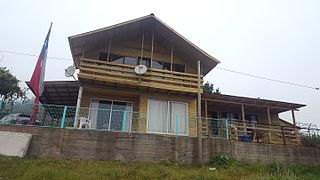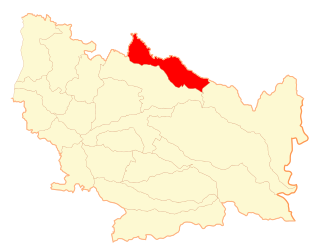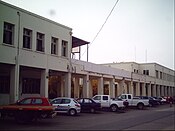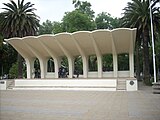
Parral is a city and commune in the Linares Province of Chile's Maule Region.

Talca is a city and commune in Chile located about 255 km (158 mi) south of Santiago, and is the capital of both Talca Province and Maule Region. As of the 2012 census, the city had a population of 201,142.

Peñalolén is a Chilean commune in Santiago Province, Santiago Metropolitan Region. It was founded on 15 November 1984.

San Javier is a Chilean city and commune located in the Province of Linares, Maule Region. The city lies in the geographical center of the country, some 270 km (168 mi) south of Santiago, 31 km (19 mi) to the northwest of the provincial capital, Linares, and 24 km (15 mi) to the south of Talca, the regional capital. The Pan-American Highway passes through the commune of San Javier, touching tangentially the eastern side of the town. A paved road connects San Javier with Colbún, Colbún dam lake and Panimávida and Quinamávida hot springs.

Villa Alegre a commune and city located in Linares Province, Maule Region of Chile. With 189.8 km2 (73 sq mi), Villa Alegre is the smallest commune by area in the Maule Region. It sits 92 m (302 ft) above sea level.

Pelluhue is a town and commune in the Cauquenes Province of central Chile's seventh region of Maule.

Chanco is a Chilean town and commune located in Cauquenes Province, Maule Region.
Colbún is a Chilean town and commune in Linares Province, Maule Region. The commune has a population of over 17,000 inhabitants and covers an area of 2,900 km2 (1,120 sq mi), making it the province's largest. Its capital, the town of Colbún, has 3,679 inhabitants. It is 7 km (4 mi) west of the center of continental Chile.

Longaví is a Chilean city and commune located in Linares Province, one of the four provinces that make up the Maule Region, in the geographical center of Chile.
Retiro is a town and commune in Chile, located in Linares Province, in the seventh region of Maule.

San Clemente is a city and commune administered by the municipality of San Clemente, located in the Talca Province of Chile's Maule Region.
Pencahue is a town and commune in Chile, located in Talca Province, in the seventh region of Maule. The commune spans and area of 956.8 km2 (369 sq mi).

El Monte is a Chilean city and commune in Talagante Province, Santiago Metropolitan Region. As of 2007, it had a population of 29,568.
Maule is a town and commune in Talca Province in central Chile's Maule Region. It takes its name from the Mapudungun words for "valley" (mau) and "rainy" (len).
Melipilla is a Chilean commune and capital city of the province of the same name. It is part of the Santiago Metropolitan Region and is a significant satellite city of the Chilean capital.

Ñiquén is a commune of the Punilla Province, located in the north of the Ñuble Region of Chile. Geographically, it is delimited by the Perquilauquén River to the north and the Ñiquén River in the south. Its boundary to the north is the commune of Parral and to the west that of Cauquenes both in the Maule Region, to the south with the commune of San Carlos, and to the east with San Fabian de Alico. The town of San Gregorio is the capital of this commune.

Talagante is a commune and the capital city of the province of the same name in the Santiago Metropolitan Region of central Chile. The word Talagante in Quechua comes from talacanta, meaning "Lazo de Hechicero", which was the proper name of the curaca, or ruler, who dominated this central valley on behalf of the Inca empire during the arrival of the Spaniards.
San Pedro is a commune of the Melipilla Province in central Chile's Santiago Metropolitan Region.
Santa María is a city and commune in the San Felipe de Aconcagua Province of central Chile's Valparaíso Region.
Nogales is a city and commune in the Quillota Province of central Chile's fifth region of Valparaíso.

















